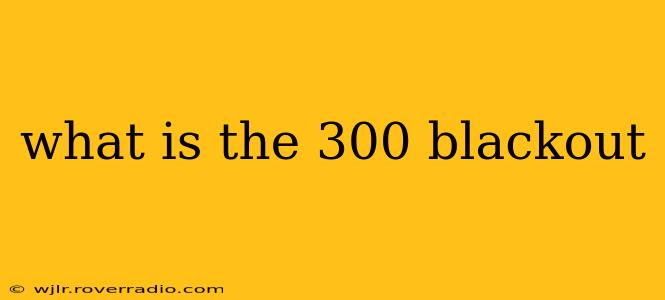The .300 Blackout (also known as 300 BLK or 7.62x35mm) is a relatively new cartridge gaining immense popularity among both civilian shooters and military personnel. Its versatility and effectiveness in close-quarters combat (CQB) situations make it a highly sought-after round. But what exactly is the .300 Blackout, and what makes it so special? Let's dive in.
What are the Key Features of the .300 Blackout?
The .300 Blackout was designed with several key features in mind:
-
Subsonic Capabilities: This is arguably its most defining characteristic. The cartridge can be loaded with subsonic ammunition, meaning the bullet travels slower than the speed of sound. This results in reduced noise, making it ideal for stealth operations or situations where noise suppression is crucial.
-
Suppression Friendly: The subsonic ammunition, coupled with the cartridge's design, makes it exceptionally well-suited for use with suppressors. The reduced noise and recoil further enhance its effectiveness in tactical scenarios.
-
Versatility in Ammunition: The .300 Blackout offers a wide range of ammunition options, including supersonic and subsonic rounds, allowing shooters to tailor their choice to the specific situation. This flexibility makes it incredibly adaptable to diverse shooting needs.
-
Effective at Close Range: While effective at longer ranges with the right ammunition, the .300 Blackout truly shines in CQB. Its relatively large bullet diameter delivers significant stopping power at close range.
-
AR-15 Compatibility: A significant advantage is its compatibility with the widely popular AR-15 platform. This means many existing AR-15 rifles can be easily converted to fire the .300 Blackout with minimal modifications (often just a barrel change).
What are the Advantages of Using a .300 Blackout?
The benefits of choosing the .300 Blackout extend beyond its technical specifications. Its popularity stems from several practical advantages:
-
Reduced Recoil: Compared to some other calibers, the .300 Blackout has manageable recoil, contributing to improved accuracy and control, especially for newer shooters.
-
Increased Accuracy: The relatively low recoil and available ammunition options allow for greater precision, crucial in tactical situations or target shooting.
-
Compact Design: The cartridge's size contributes to its suitability for short-barreled rifles, making it highly maneuverable in tight spaces.
What are the Disadvantages of the .300 Blackout?
While it boasts many advantages, the .300 Blackout also has some drawbacks to consider:
-
Cost: .300 Blackout ammunition can be more expensive than some other more common calibers.
-
Limited Availability (compared to 5.56 NATO): While growing, the availability of .300 Blackout ammunition might not match that of more widely used calibers like 5.56 NATO.
-
Reduced Range (compared to 5.56 NATO): While effective at close to medium ranges, the .300 Blackout has a shorter effective range than some alternative cartridges like 5.56 NATO, especially with subsonic rounds.
What are Some Common Uses for the .300 Blackout?
The versatility of the .300 Blackout makes it suitable for a range of applications:
-
Home Defense: Its stopping power and manageable recoil make it a popular choice for home defense.
-
Hunting: The .300 Blackout is effective for hunting smaller game at shorter ranges.
-
Law Enforcement: Some law enforcement agencies utilize the .300 Blackout for its close-quarters combat effectiveness and noise suppression capabilities.
-
Military Applications: Special forces and other military units employ the .300 Blackout for its stealth and close-range stopping power.
Is the .300 Blackout Right for Me?
The suitability of the .300 Blackout depends on your specific needs and preferences. Consider the factors discussed above – cost, range requirements, noise considerations, and intended use – before making a decision. Researching various ammunition types and the performance of different rifles chambered in .300 Blackout will further help you determine if it's the right cartridge for you.
This information is for general knowledge and informational purposes only, and does not constitute professional advice. Always consult with a firearms expert before handling any firearm.
